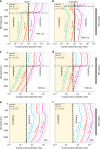Formation of bridgmanite-enriched layer at the top lower-mantle during magma ocean solidification
- PMID: 31992697
- PMCID: PMC6987212
- DOI: 10.1038/s41467-019-14071-8
Formation of bridgmanite-enriched layer at the top lower-mantle during magma ocean solidification
Abstract
Thermochemical heterogeneities detected today in the Earth's mantle could arise from ongoing partial melting in different mantle regions. A major open question, however, is the level of chemical stratification inherited from an early magma-ocean (MO) solidification. Here we show that the MO crystallized homogeneously in the deep mantle, but with chemical fractionation at depths around 1000 km and in the upper mantle. Our arguments are based on accurate measurements of the viscosity of melts with forsterite, enstatite and diopside compositions up to ~30 GPa and more than 3000 K at synchrotron X-ray facilities. Fractional solidification would induce the formation of a bridgmanite-enriched layer at ~1000 km depth. This layer may have resisted to mantle mixing by convection and cause the reported viscosity peak and anomalous dynamic impedance. On the other hand, fractional solidification in the upper mantle would have favored the formation of the first crust.
Conflict of interest statement
The authors declare no competing interests.
Figures




References
-
- Carlson RW, et al. How did early earth become our modern world? Annu. Rev. Earth Planet. Sci. 2014;42:151–178. doi: 10.1146/annurev-earth-060313-055016. - DOI
-
- Solomatov VS. Fractional versus equilibrium crystallization. Magma oceans and primordial mantle differentiation. Treatise Geophys. 2007;9:91–120. doi: 10.1016/B978-044452748-6/00141-3. - DOI
Grants and funding
LinkOut - more resources
Full Text Sources

